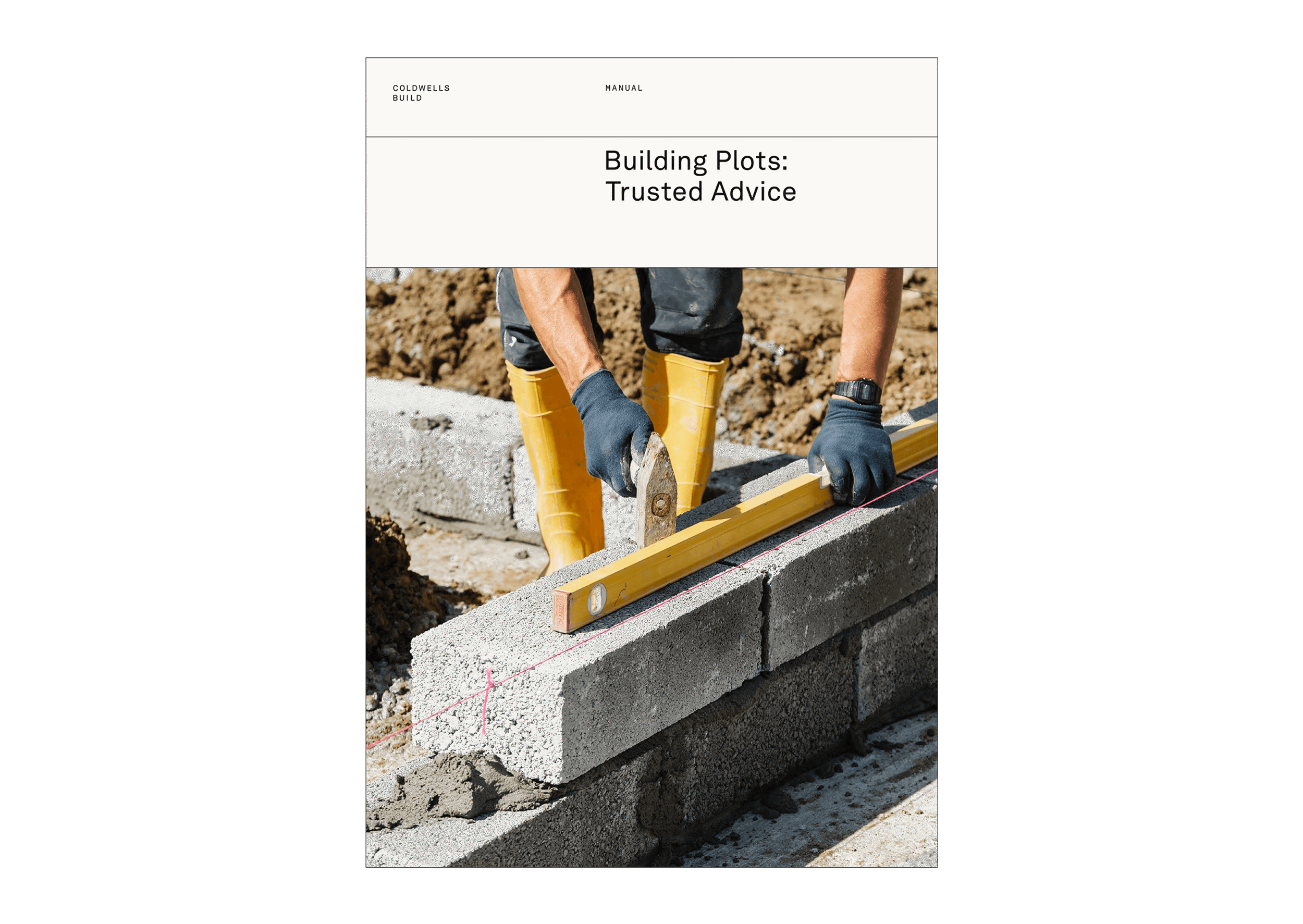
Building Plots: Trusted Advice
A self-builder's guide to finding the perfect plot, evaluating its suitability and understanding the legal considerations involved.
Download
Where should you start with a new build garden? TV gardener, Scott Smith and garden designer, Iona Hilleary share their ideas to transform a bare, empty plot in Scotland.
After the builders have long gone and you're living in your beautiful new home, attention often turns to the empty outdoor space that's been left behind.
New build gardens present a unique set of challenges and opportunities, and for many homeowners, knowing where to start can be daunting.
Here to help is Scott Smith, former head gardener of BBC Scotland's Beechgrove Garden and esteemed garden designer, Iona Hilleary. In this blog, they share their garden ideas and expert advice to get the best from your blank canvas.
Firstly, spend time thinking about your garden budget and how much you can reasonably afford to invest.
"The garden is an external living room, with changing beauty potentially in all seasons to enjoy from the house", Iona says "Your budget should reflect your enjoyment of this space".
Just like your home, a well designed garden will create a lifetime of happiness and joy.
"I always advise that whatever you would spend on a new kitchen is what you should spend on a garden", says Scott.
Next, decide on the purpose of your garden and how the space will be used. "Whether for relaxation, games, or to be looked at from the house, the desired functionality will help to structure a development process", says Iona.
Consider what you need in the space. Look for ideas in magazines and online and start to pull together a mood board.
"A garden is an extension of your personality and lifestyle", says Scott. "Will you need a shed? Will you want a seating area? Where will you get rid of garden waste and grass clippings? A garden has to be practical as well as pretty."
Once you know what you want in your garden, think about its orientation (north, east, south, west). Make notes about where the sun rises and falls, as this will affect the positioning of certain areas.
"You don’t want a BBQ patio in a north facing spot that’s always in shade", says Scott. "This will affect the plants, too. Certain plants love shade whilst others need full sun."

Once you know how you want your garden to look, it pays to use a reputable garden designer to bring your ideas to life.
"A garden designer should target their advice on the issues the client most needs help with, highlighting the strengths and weaknesses of a site and how best to resolve these cost-effectively" says Iona.
Professional garden designers have good connections and will use their trusted subcontractors to undertake the work.
"If you're keen to do it yourself, then be completely honest: can you do hard landscaping like building walls, laying patios or implementing fountains?" says Scott. "Can you do soft landscaping, like selecting, then planting trees and shrubs that will actually survive and thrive?"
It's common for a new build plot to have undulation and gradients, so sorting out the topography (soil layout) is one of the first big jobs to tackle.
Once your soil is at the correct height and shape, utility works can begin. This includes laying drainage for wet sites, water connections and electrical wiring for lights and fountains.
Next comes the hard landscaping. It's better to do this before you've added plants, as you won't need to worry about damaging precious new specimens. At this stage, fountains and patios are installed, followed by walls, slabs and paths.
A winding path is a great way to make a garden feel bigger and creates destinations to different areas. "Work from the house outwards, with paths and terracing leading to lawns, seating and focal points." says Iona.
One of the most common problems with new-build gardens is poor soil quality. Often it's been compacted by heavy machinery and is full of builder's rubble.
"Soil quality and drainage will determine the success of your plants and grass, so it's prudent to allow a portion of your budget to be allocated to these unseen but vital elements", says Iona.
Prepare the ground for plants or lawn by digging it over and removing any building debris and rubbish. It's also a good idea to add organic matter.
"A new build garden is likely to have a thin layer of decent topsoil and be straight into innutritious subsoil", says Scott. "Consider ameliorating your soil by adding new topsoil and compost to create depth. You’ll want at least 15cm depth for new shrubs and herbaceous plants."
It's also important to determine the soil type you're working with by testing your soil's pH.
"Some plants like acidic soil and some like alkaline soil. Check your soil with a home test kit and this will help narrow down the plants which will thrive in your new garden." says Scott.

The best time to lay lawn is in spring and autumn so the grass will root.
"Summer is too hot and dry for turf and seed to establish without a wasteful amount of water", says Scott. "And winter will likely have frosts and cold that may kill off newly establishing seed and turf strips."
If the builders have left you with a large, rectangle lawn, take advantage of it.
"Don’t be apprehensive of geometry as this can be softened with planting, whether in garden borders or in the grass", says Iona.
If straight lines aren't your thing, a simple shape, such as a circular lawn can work well.
"Curved shapes create interest and encourage exploration. Having a curved lawn will instantly make the garden more exciting", says Scott.
Heading straight to the garden centre and buying lots of plants will add up fast, so be smart about your purchases. A clever design and a planting plan will help you stay on budget.
"A garden designer can draw up a plant schedule with the correct spacings of planting so you're getting enough plants of the right size to ultimately fill the space and minimise weeding", says Iona. "Focus your plant budget on one or a few large items, whether these be a feature tree or some pretty multi-stemmed flowering shrubs."
The rest of your budget can be spent on cost-effective herbaceous perennials and shrubs. These types of plants will grow quickly and provide good bang for your buck.
"They will return year after year", says Scott. "In a new garden don’t bother with shiny, fancy annuals. You’ll reap the rewards by investing in things that will keep coming back, or be a permanent feature. These can later be propagated to create more of them, via division and cuttings."
"The best planting season is Autumn to allow your plants to get their roots down before the heat of the following summer. This timing will maximise their chance of establishment", says Iona. "The exception being if you love Mediterranean plants or have water-retentive clay soil, which could risk your new plants sitting in cold water over the winter."
With the stress of moving, it can be easy to forget about plants you've brought with you. Spend an afternoon planting them into the ground, but consider your garden's aspect when doing so.
"Are you at the bottom of a valley where it's a frost pocket? If so, you’ll need plants that are hardy to H5 which survive to minus 20", says Scott.
Also, think about how exposed your garden is.
"Are you in a bare field or a seaside location blasted by high winds? If so, you’ll need some shelter first created by planting tough trees or shrubs like Leyland Cypress or Sea Buckthorn."

Privacy is a major desire in any new build house. With a lack of mature trees, neighbours can often peer directly into your property. A good rule of thumb is to plant a hedge, although be careful of the type you choose.
"People often plant Leyland Cypress (X Cupressus leylandii) but this is a fast growing hedge that needs pruning three times a year", says Scott. "If you don’t want that much work, then consider a slower type like yew (Taxus baccata) or beech (Fagus sylvatica) which only needs trimmed once a year."
Pleached trees also help create privacy - they're trained to produce an elevated, leafy screen by tying in and interlacing flexible young shoots along a supporting framework. Lime trees (Tilia platyphylllos) work well for this.
"Pleached or espaliered trees takes up little space and can be very pretty with spring blossom", says Iona. "Alternatively there are very good horizontal trellis screens which can be attached to walls and decorated with climbers if so desired."
When creating your garden transformation, don't worry about making mistakes. A garden is a living and breathing organism. It ebbs, flows and changes over time.
"If you don’t get it perfect the first time, then so what? We live and learn", says Scott. "Mistakes are how we grow. I’ve learned far more from my mistakes than my successes."
Remember, gardening is all about trial and error, so enjoy creating your oasis of calm.
"Follow your gut and do exactly what you like", says Iona. "There is no right or wrong. It should be fun and a pleasure to be in your garden and to watch it grow."

A trained communicator, Clare co-founded Coldwells Build with the aim of improving consumer experience within the construction process. Working previously as a television director and journalist, she understands more than most, about the power of detail, organisation and timing.
by signing up you agree to our Privacy Policy.

Thanks for signing up. You’ll receive an email once a month packed with building tips, advice and updates on Coldwells Build projects.
We’ve created 8 free-to-download guides packed with tips on budgeting, plot finding and self-building. Essential reading for anyone planning to build their home.

A self-builder's guide to finding the perfect plot, evaluating its suitability and understanding the legal considerations involved.
Download